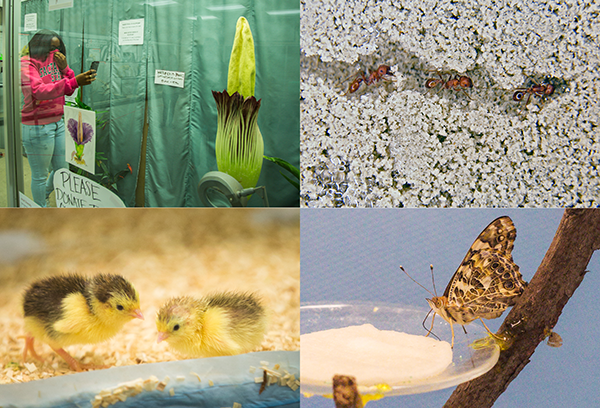 Living Gallery exhibits, clockwise from top left: the corpse flower, ant farm, painted lady butterflies, and button quail.
Living Gallery exhibits, clockwise from top left: the corpse flower, ant farm, painted lady butterflies, and button quail.Related stories:
"Corpse flower blooms in Sequoia Hall"
"Family-friendly fish frolic in Living Gallery"
A close-knit family of fish is the latest subject in Sacramento State’s series of Living Gallery exhibits. The displays have drawn considerable interest from students and the public, and raised the visibility of the University’s Biological Sciences Department.
And it all started with one foul-smelling flower.
In March 2015, Sacramento State’s corpse flower specimen was getting close to blooming. Since the massive plant flowers only every decade or so, this was something of an event. So the plant was moved to the exhibit case in Sequoia Hall where everyone could follow the slow process.
So named for its unmistakable odor, the corpse flower eventually was moved to another room because it just got too big, but it still attracted a considerable number of Sac State students, field trips, media, and others – even some from out of state – curious about the unique biological entity.
The original idea for the Living Gallery was a collaboration between former Department Chair Ruth Ballard and Department biologist Merrill Roseberry. They were looking for some way to incorporate dynamic, living organisms with the excellent museum collections in the department.
“We wanted to utilize a prime location in Sequoia Hall to exhibit the wonders of the natural world in a way that was accessible to people of all ages and backgrounds,” Roseberry says.
The corpse flower was a huge success, and more exhibits followed.
An ant farm measuring 36 inches wide and 30 inches tall was placed in the display case in June 2015. Crisscrossed with tunnels, the farm also had a large, movable magnifying glass on the exterior so viewers could get up close and personal with the insects. This particular species was known in the wild for building granaries where they stored seeds for the winter.
The following November, a flutter of butterflies made the display case their home. The exhibit began at the beginning. Passersby were able to witness the entire life cycle, from tiny specks of eggs, to caterpillar, then chrysalis, and, finally, a butterfly. The species, painted lady butterflies, resembled smaller versions of monarchs, sporting orange, black, and white markings.
When all the butterflies had run through their life cycles, they were replaced with another winged species – button quail.
Once again, the display began with a collection of eggs so viewers could watch them hatch and grow. The flightless birds are about the size of a small fist, and are born ready to explore and eat. Needless to say the cute balls of fluff have been very popular.
The quail exhibit was open during Spring 2016 and closed Thursday, May 19.
“Hopefully our exhibits ignite an interest in our visitors that fuels them to continue learning after they have left our display,” Roseberry says.
For the summer of 2016, Professor Ronald Coleman has stepped in with a display of cichlids, a type of fish that are doting parents when their newborns are hatched. And come fall, Roseberry returns with an exhibit focusing silkworms. – Craig Koscho
